Loaded with vegetables, mushrooms, and tofu, my easy Sesame Miso Hot Pot is an ideal dish to make with friends and family. With a savory and nutty broth, this Japanese one-pot recipe will warm your belly and soothe your soul. {Vegan Adaptable}
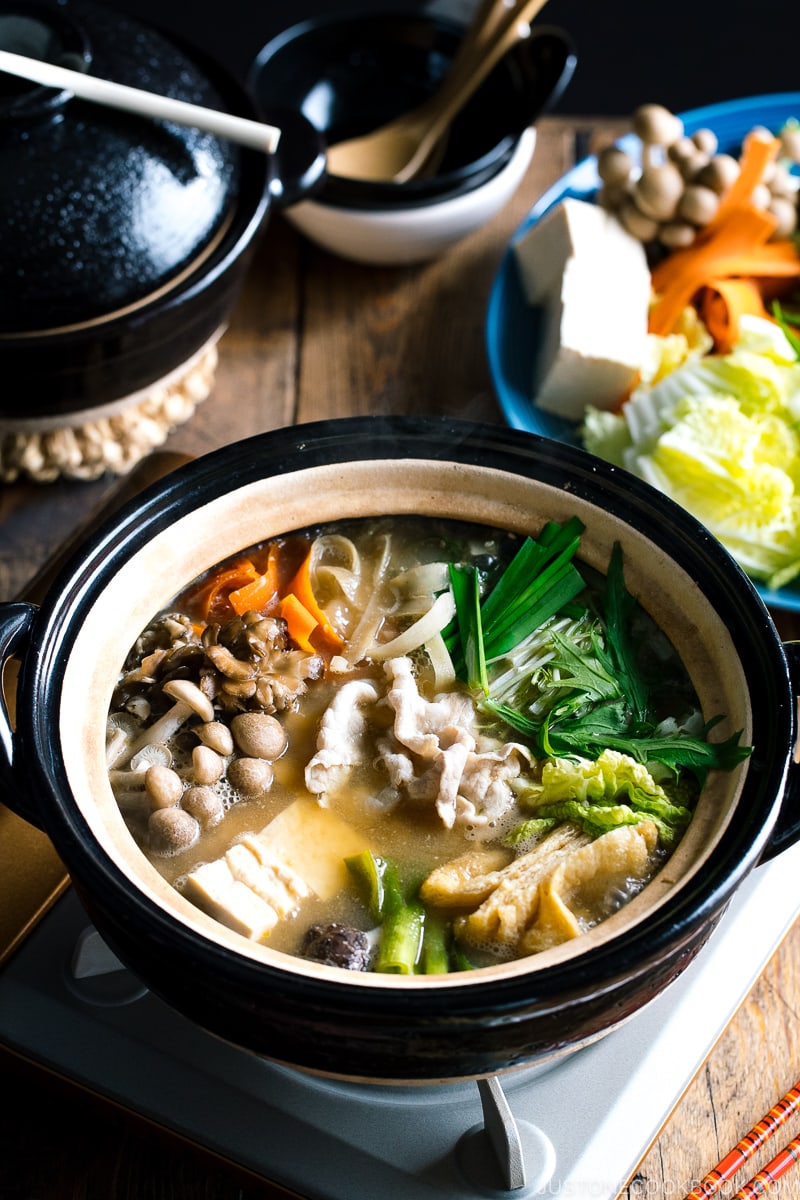
When it’s cold or rainy outside, all I want to do is to stay in and eat warm hot pot dishes. Luckily, my whole family loves a hot pot, or what we call Nabe in Japanese, so I have a lot of hot pot recipes stored in the back of my head (and here on the blog).
Today I’m sharing Sesame Miso Hot Pot or in Japanese Goma Miso Nabe (胡麻味噌鍋). The savory, nutty, umami-rich broth will keep you cozy all night. You can easily leave out the meat to make it vegan-friendly too.
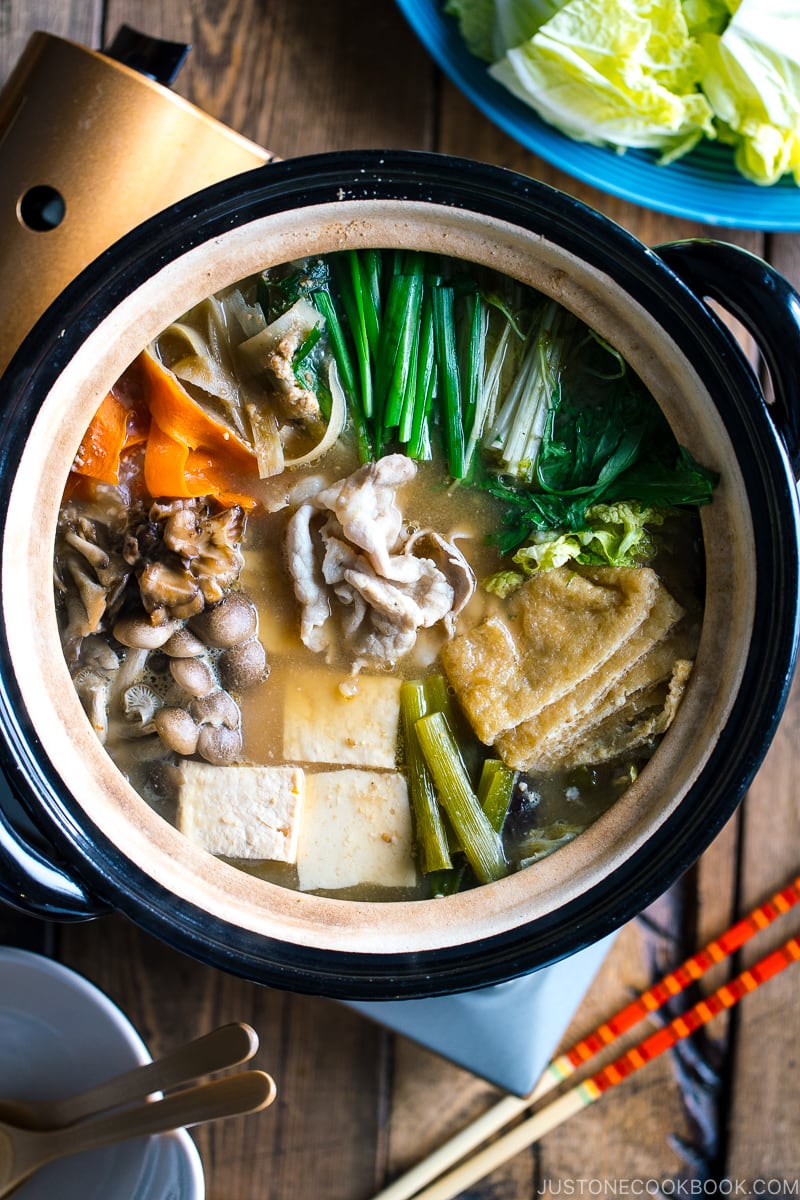
Why We Should Make Sesame Miso Hot Pot
- Soothing and amazingly flavorful soup broth.
- It requires only common Japanese ingredients.
- Incredibly easy to prepare and to customize based on your (guests) needs.
- Best way to eat lots of veggies!
- Vegan soup broth for everyone to enjoy.
Plus, did you know most hot pot dishes use similar ingredients? If you have any leftover vegetables, make a different style of hot pot in the same week!
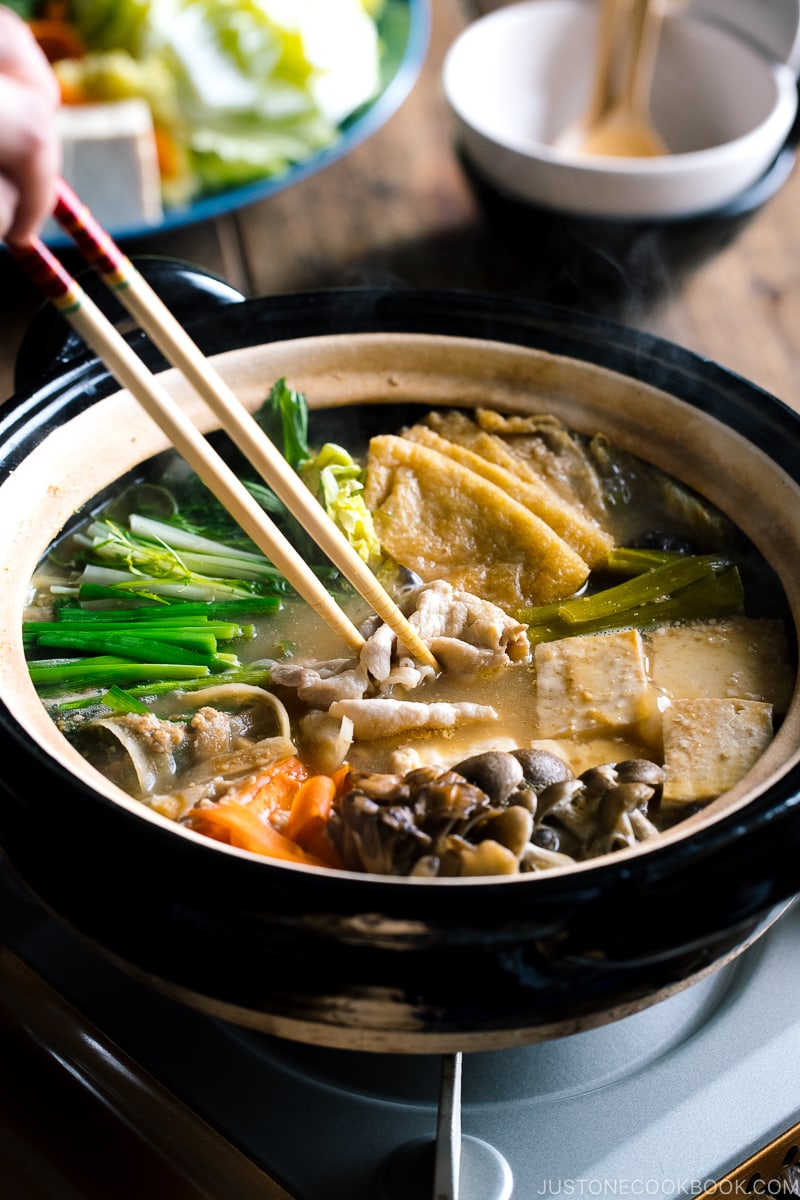
How to Make Sesame Miso Hot Pot
The best thing about hot pot dishes is that you can prepare everything ahead of time and have everyone cook together at the table.
It’s as simple as:
- Make the Soup Broth – Japanese soup broth or dashi is so easy to make!
- Cut the ingredients – This is the only prepping you pretty much need to do, and set the table with a portable butane stove.
- Cook & enjoy – Throw the ingredients into the hot pot, crank the heat, and everyone cooks and eats at the same time. Isn’t it the best?
3 Ingredients for Making the Soup Broth
1. Vegan Kombu and Dried Shiitake Dashi
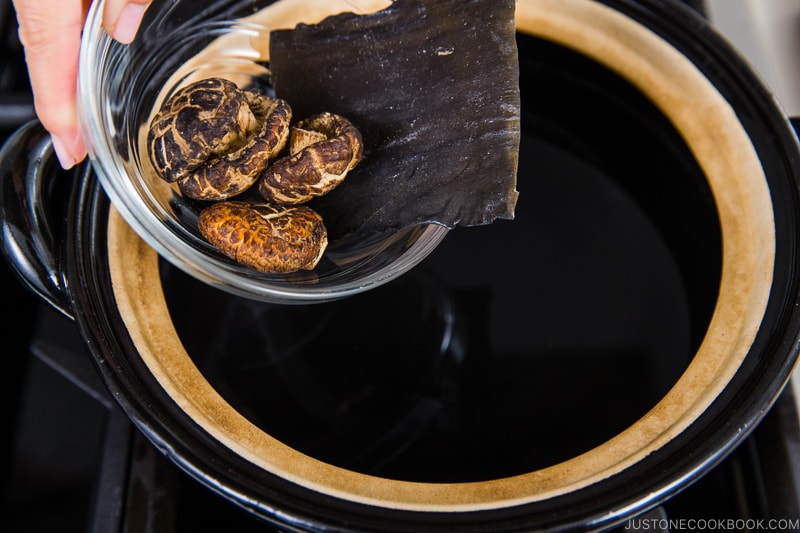
Many people think “dashi”, or Japanese stock, is a seafood-based broth and it is not vegan-friendly. However, that’s not true.
As I explained in detail in The Ultimate Dashi Guide, we have 5 different types of dashi, from vegan-friendly dashi to seafood-based dashi.
In this recipe, we use kombu (dried kelp) and dried shiitake mushrooms for the broth, which are ingredients high in glutamates. Not only you can yield an umami-rich broth in a very short time, but they also offer plenty of health benefits.
2. Miso
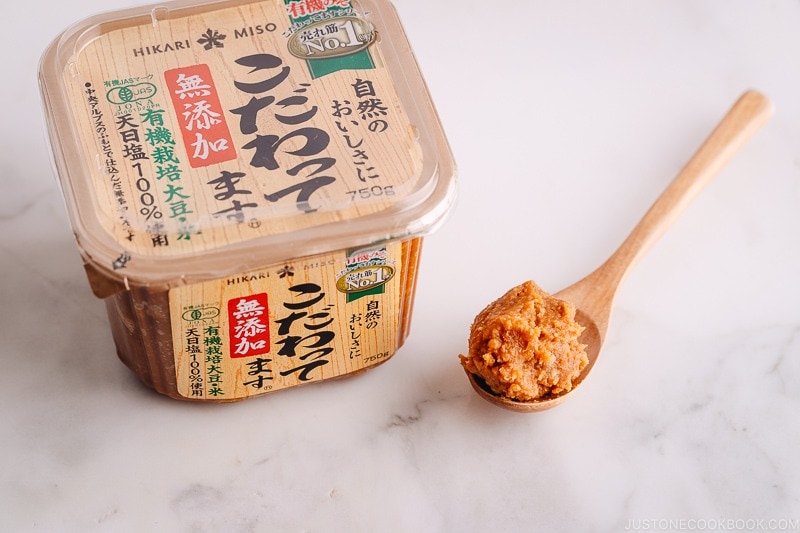
In case you haven’t realized, I’ve been sharing delicious miso recipes every month in partnership with my favorite miso company, Hikari Miso. While I enjoy cooking with different kinds of miso, this organic Kodawattemasu Miso is by far my favorite.
Every type and brand of miso has a different level of saltiness, so you have to taste and adjust the desired amount of miso for your soup broth.
3. Sesame Seeds
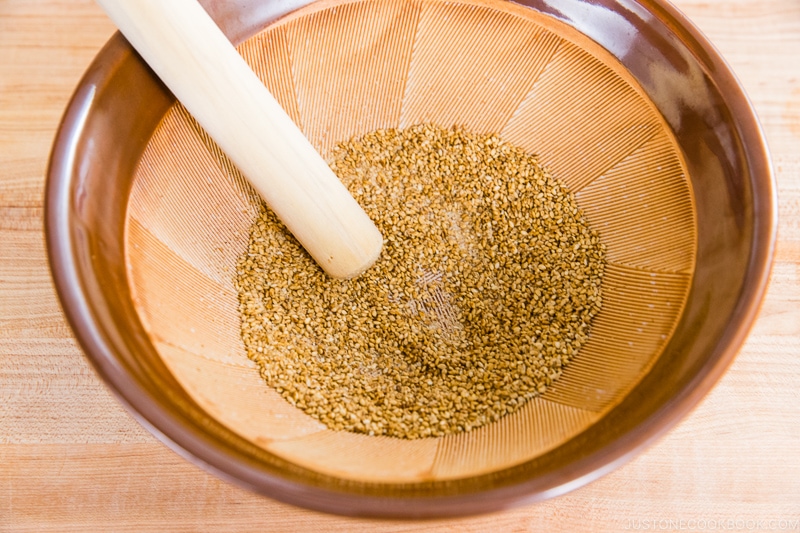
Let’s talk about the final important ingredient — sesame seeds. I always recommend toasting the sesame seeds before you use them. Even though the package of your sesame seeds says “toasted”, it’s not comparable when you smell the just-toasted sesame seeds. It’s a quick extra step, but you can bring out even more flavors by simply toasting them in a non-greased frying pan.
After toasting, we would grind the sesame seeds into powder. Japanese household typically has a ceramic mortar and wooden pestle called Suribachi and Surikogi. The mortar has unique and beautiful unglazed grinding grooves on the inside which makes the job easier.
My mom passed hers (above) down to me to replace the small and inexpensive Suribachi I bought when I was in college. I’d recommend getting a large one like this if you are looking for one. It’s much easier to grind without worrying about spilling the sesame seeds.
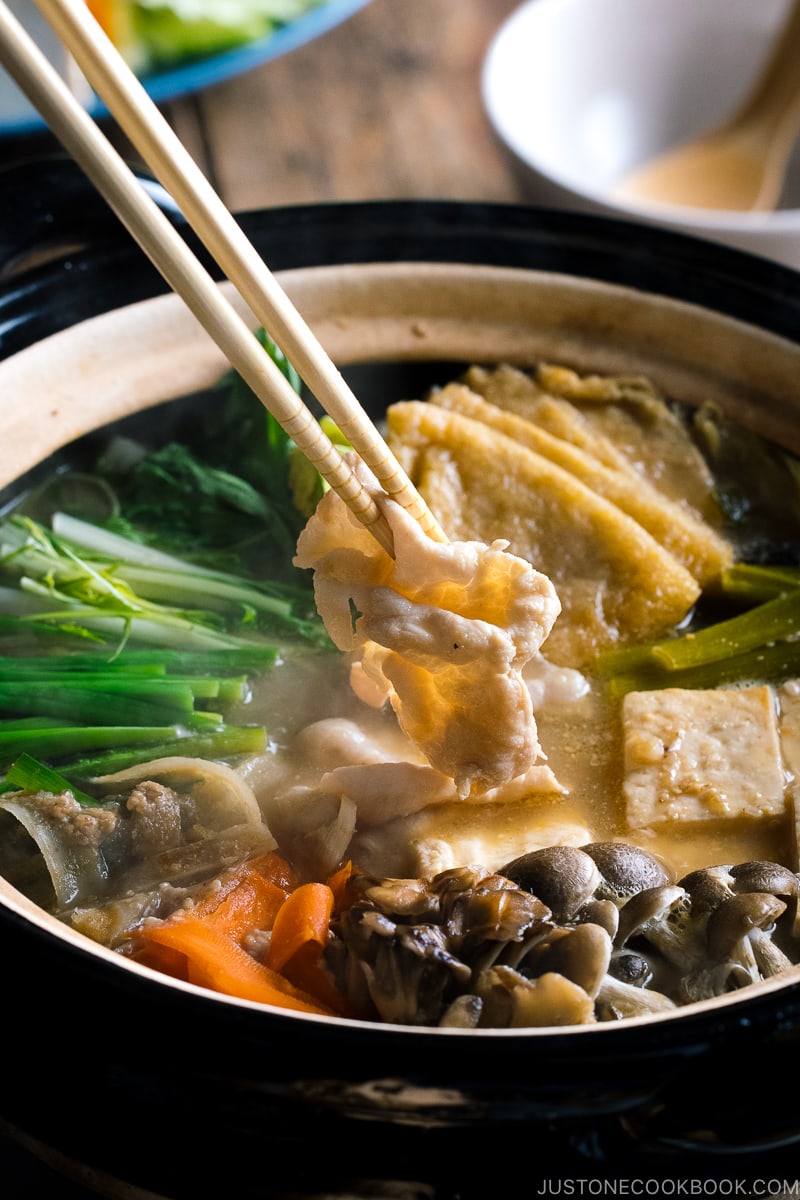
How to Serve Sesame Miso Hot Pot
When serving a hot pot as the main dish for a party, I may serve one or two small sides on the side. But if it’s just for my family, I’d skip the side dishes and we’d just eat a hot pot. All the nutritious ingredients are all in the pot already. Sides would be a luxury.
So besides the earthenware donabe hot pot in the middle of the table, each person has a bowl of rice and a medium-size bowl for the food from the hot pot. Here is what you need to prepare for your table:
- A portable butane stove.
- A donabe (or a large shallow pot so you can see inside the pot from your seat)
- A couple of communal ladles, long cooking chopsticks, or tongs.
- A platter of chopped vegetables, tofu, mushrooms, and meat (if you’re serving).
- Any sides you want to offer (optional).
Now sit back and enjoy your time over the delicious hot pot with your family and friends.
Can I Use an Electric Hot Pot?
While I prefer using a donabe to make Sesame Miso Hot Pot, you can also use an electric hot pot to make this dish. I own the highly reviewed Zojirushi Gourmet d’Expert Electric Skillet, which you can get for $159 at Amazon. I use it as both a hot pot and a skillet and it’s great for serving a big group. That’s why it earned my top pick in my roundup of electric hot pots!
Other Unique & Delicious Hot Pot Recipes To Try:
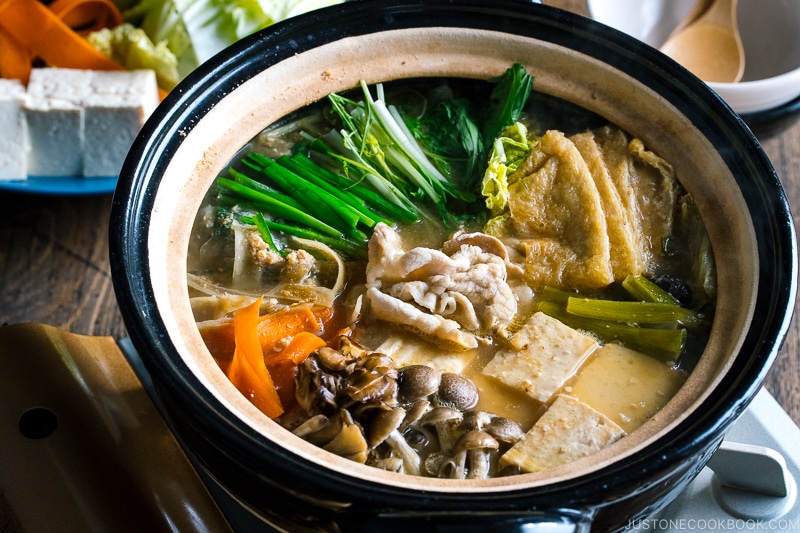
Wish to learn more about Japanese cooking? Sign up for our free newsletter to receive cooking tips & recipe updates! And stay in touch with me on Facebook, Pinterest, YouTube, and Instagram.

Sesame Miso Hot Pot (Goma Miso Nabe)
Ingredients
- 1½ lb napa cabbage (8 leaves)
- 5 green onions/scallions (2 oz, 57 g)
- 6 stalks mizuna (Japanese mustard green) (3 oz, 85 g; or other leafy greens)
- 1 bunch garlic chives (Chinese chives or Nira) (2 oz, 57 g)
- 2 pieces aburaage (deep-fried tofu pouch) (1.4 oz, 40 g)
- 1 medium-firm tofu (momen dofu) (14 oz, 397 g)
- 1 package shimeji mushrooms (3.5 oz, 100 g; or other mushrooms)
- 1 package maitake mushrooms (3.5 oz, 100 g; or other mushrooms)
- 1 carrot (5 oz, 140 g)
- 1 gobo (burdock root) (5 oz, 140 g)
- 1 lb thinly sliced pork loin (skip for vegan/vegetarian)
For the Broth
- 5 cups water
- 1 piece kombu (dried kelp) (0.2 oz, 5 g; 3 x 3 inches, 7.6 x 7.6 cm per piece)
- 4 dried shiitake mushrooms (0.7 oz, 20 g)
- 3 Tbsp toasted white sesame seeds
- 2 cloves garlic
- 2 Tbsp sake
- 1 Tbsp mirin
- 4 Tbsp miso (to taste; I use Hikari Miso® Kodawattemasu; adjust the amount based on the type you use)
For the Seasonings (optional)
Instructions
- Gather all the ingredients.
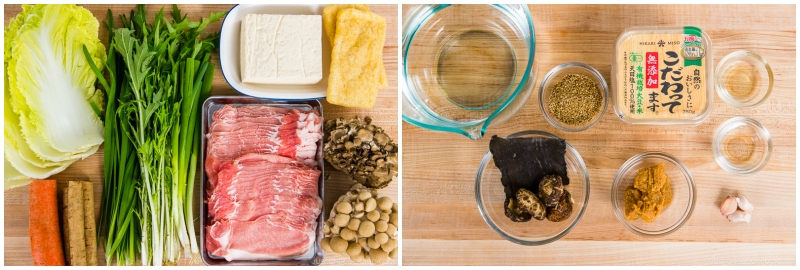
To Prepare the Soup Stock
- In a large donabe (earthenware pot, or any large, shallow pot), add 5 cups water, 1 piece kombu (dried kelp), and 4 dried shiitake mushrooms to make cold brew, vegan-friendly dashi. Set aside to steep while you prep the other ingredients.
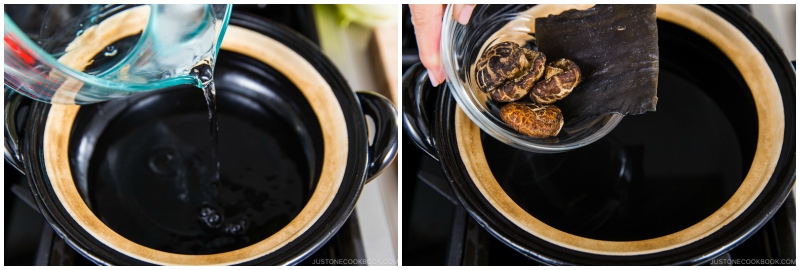
To Prepare the Hot Pot Ingredients
- In a large, ungreased frying pan, add 3 Tbsp toasted white sesame seeds and toast them until fragrant.
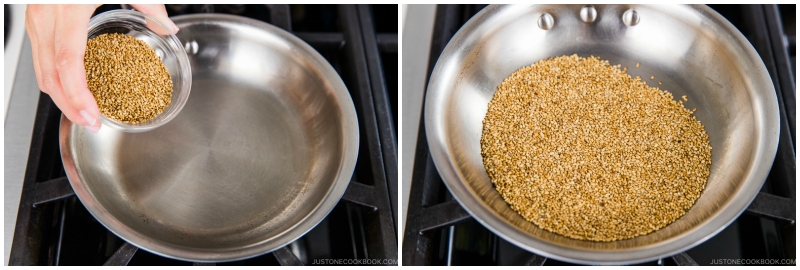
- Transfer to a Japanese mortar and pestle (suribachi and surikogi). Grind until 90% of the sesame seeds are crushed, keeping 10% uncrushed for texture.
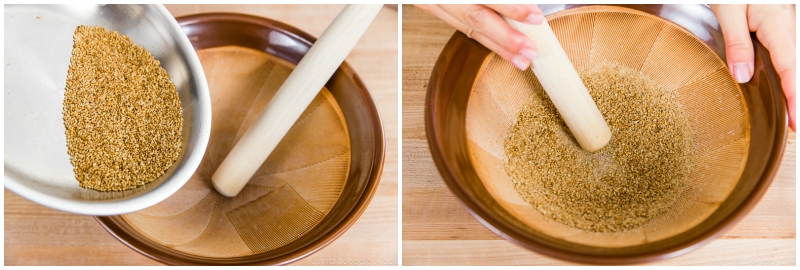
- Cut 1½ lb napa cabbage into bite-size pieces. Place them on a large platter.
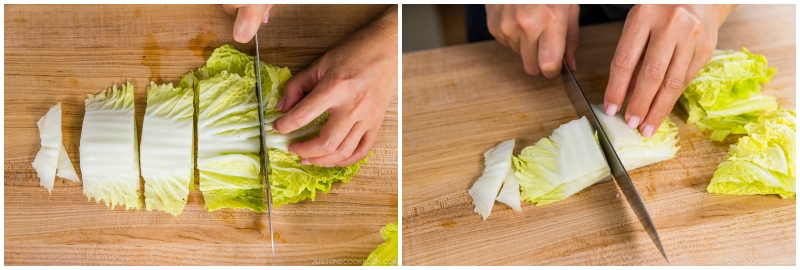
- Cut 5 green onions/scallions, 6 stalks mizuna (Japanese mustard green), and 1 bunch garlic chives (Chinese chives or Nira) into 2-inch (5-cm) pieces.
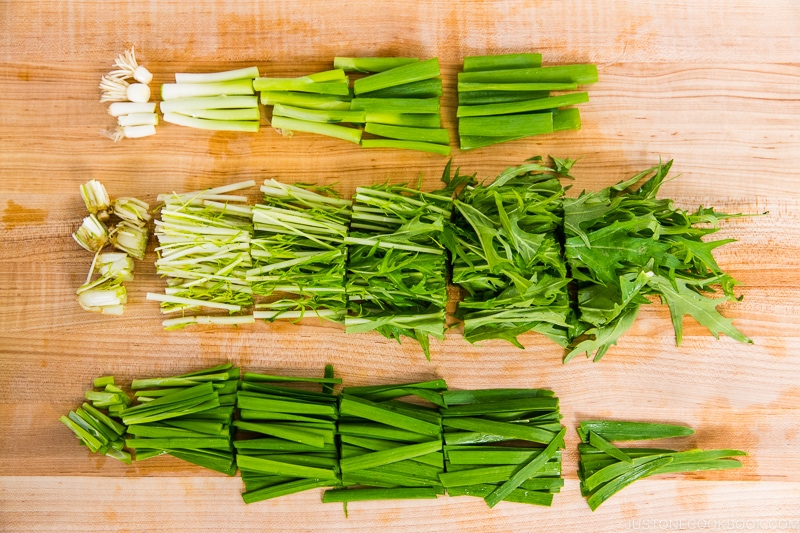
- To remove the excess oil from the aburaage, you have two options: 1) Put the aburaage in boiling water for 15 seconds, flipping once, or 2) blot the oil with a paper towel. I recommend the first option.
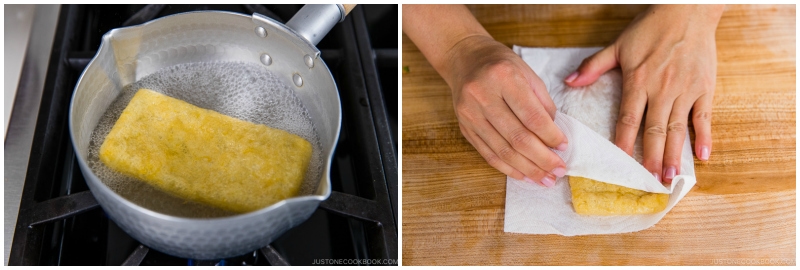
- Cut 2 pieces aburaage (deep-fried tofu pouch) crosswise into 1-inch strips. Cut 1 medium-firm tofu (momen dofu) block into 9 cubes.
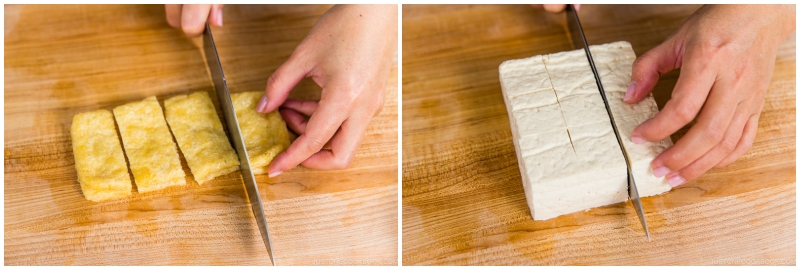
- Cut off and discard the bottoms of 1 package shimeji mushrooms and 1 package maitake mushrooms.
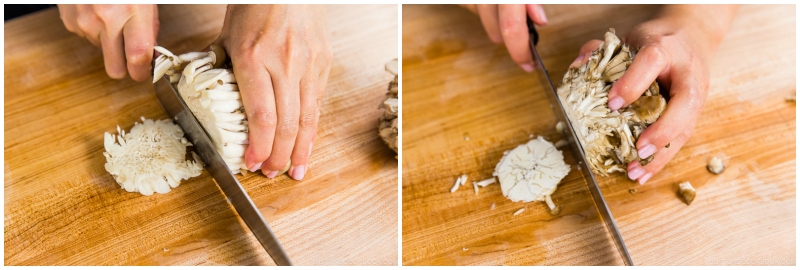
- Peel and discard the outer skin of 1 carrot. Using the same vegetable peeler, thinly peel the carrot lengthwise into thin strips.
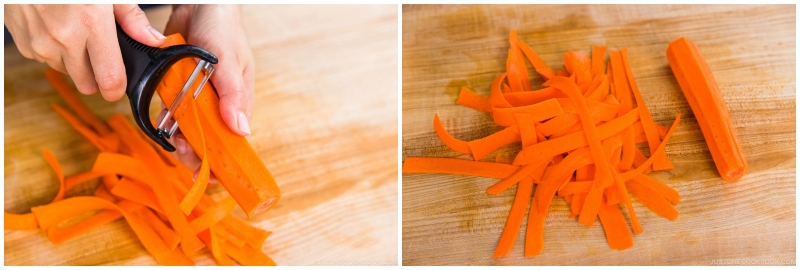
- Using the back of the knife, scrape off the skin of 1 gobo (burdock root). The flavor of the gobo is right below the skin, so you do not want to peel it away using a peeler. Then, just like the carrot, peel the gobo into strips with the peeler.
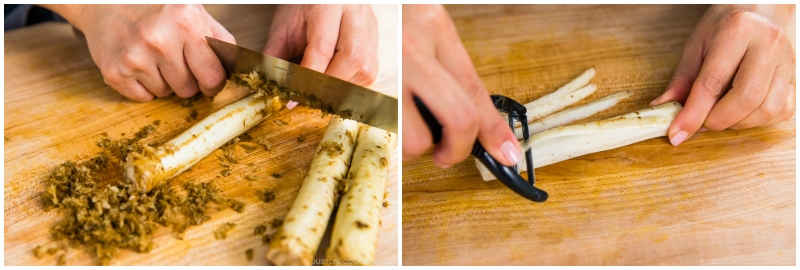
- Soak the gobo in water to prevent browning and to remove the bitter taste.
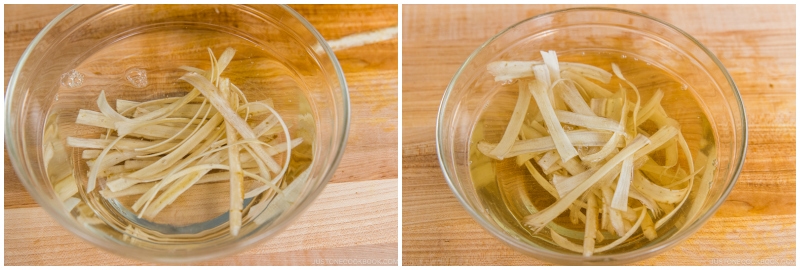
To Season the Soup Stock
- Set the donabe with the soup stock ingredients over medium-low heat. Cover and slowly bring it to a simmer. Once simmering, skim off the foam and scum from the dashi.
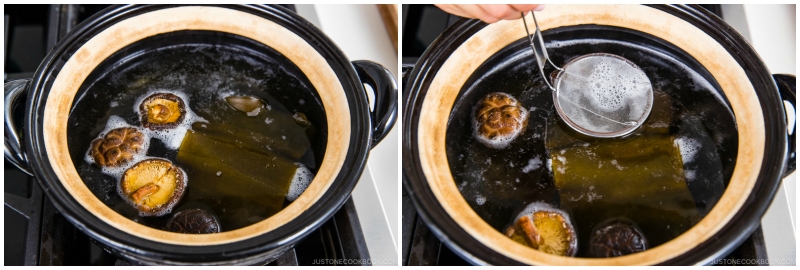
- Remove the kombu (you can reserve it to make Simmered Kombu or Furikake Rice Seasoning). Mince and add 2 cloves garlic (I use a garlic press).
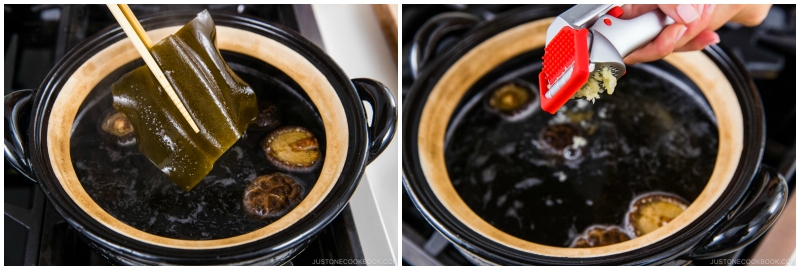
- Add 2 Tbsp sake, 1 Tbsp mirin, and 4 Tbsp miso. Let the miso completely dissolved in the ladle before releasing it to the broth.
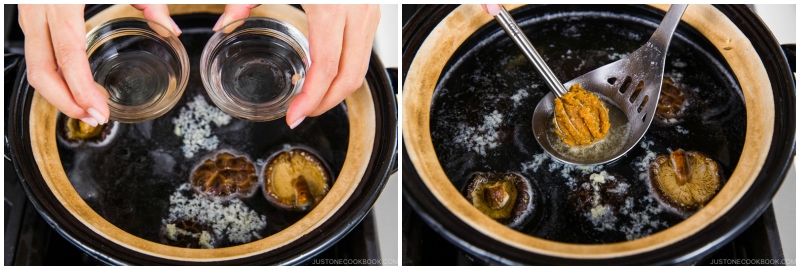
- Add the ground sesame seeds.
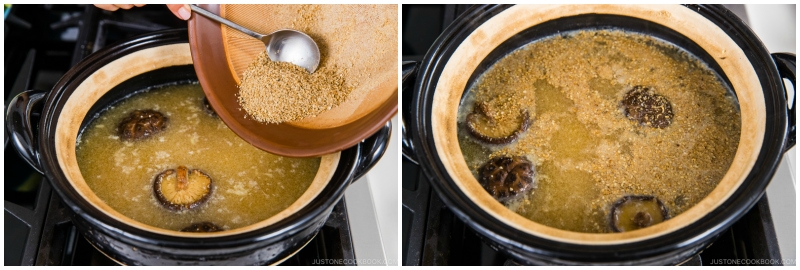
- Taste the broth (very important!), and adjust the flavor. I added an additional 2 Tbsp miso. You can add Diamond Crystal kosher salt or doubanjiang (spicy chili bean paste) if you like it spicy.
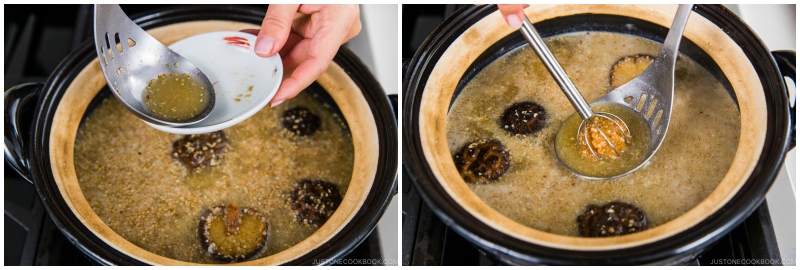
To Cook the Hot Pot
- From this point, you can bring the pot to the table to cook OR you can partially cook in the kitchen first and bring it to the table. Also, bring the platter of ingredients, ladles, chopsticks, and other cooking utensils you need to the table (see my post).
- You will cook the hot pot in batches. First, add some of the tough/dense ingredients to the broth, such as the tough part of the napa cabbage, followed by the tofu, carrot, and gobo.
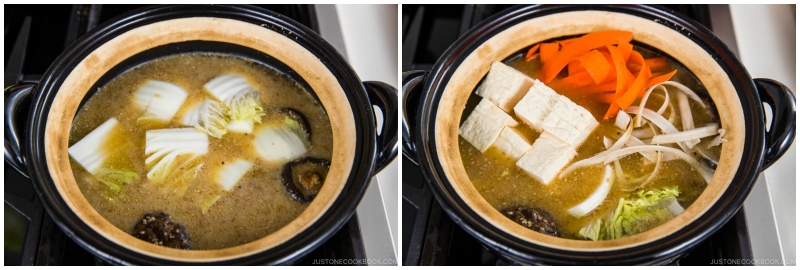
- Then, add some of the aburaage and green onion. Cover to cook for 10 minutes.
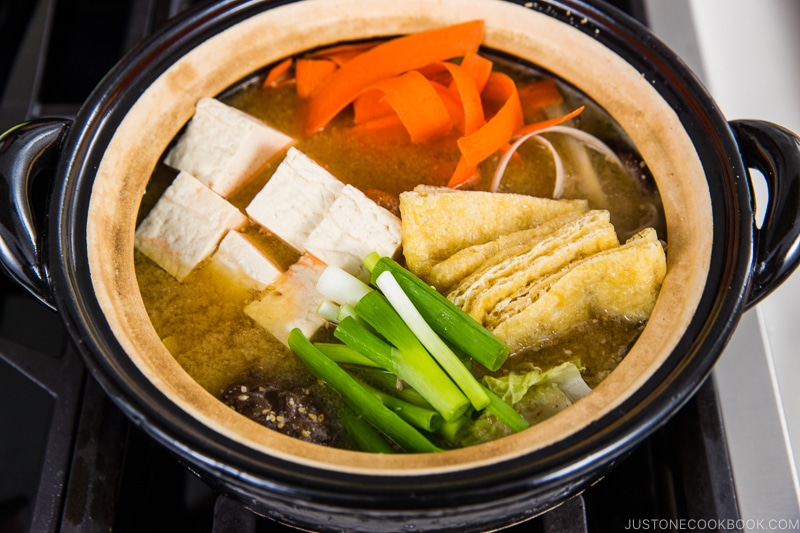
- Add some of the 1 lb thinly sliced pork loin and leafy ingredients that will cook fast. Pick up the cooked food and enjoy while hot. Once the cooked ingredients are served and cleared from the pot, add the next batch of ingredients and continue cooking. Enjoy! Sprinkle shichimi togarashi (Japanese seven spice) at the table for an extra spicy kick.

To Store
- You can keep the leftovers in an airtight container and store them in the refrigerator for up to 2 days.
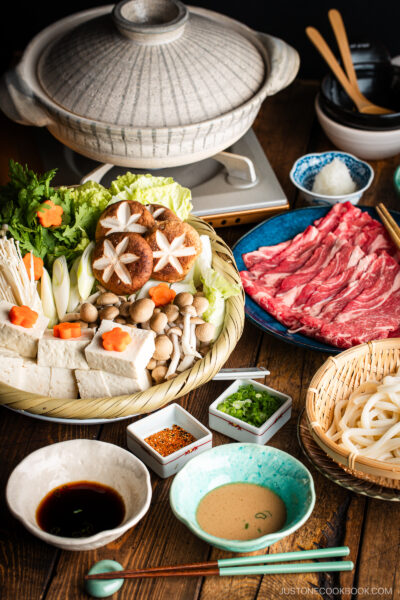
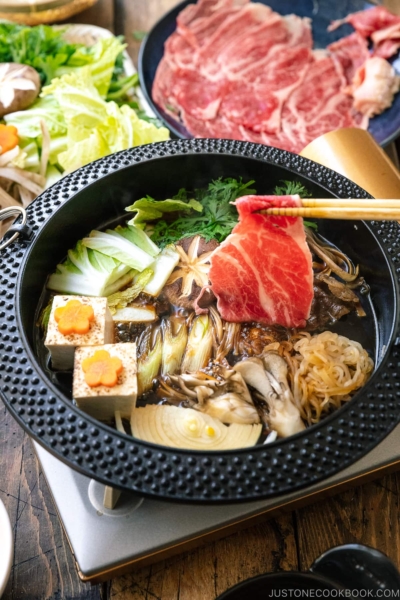
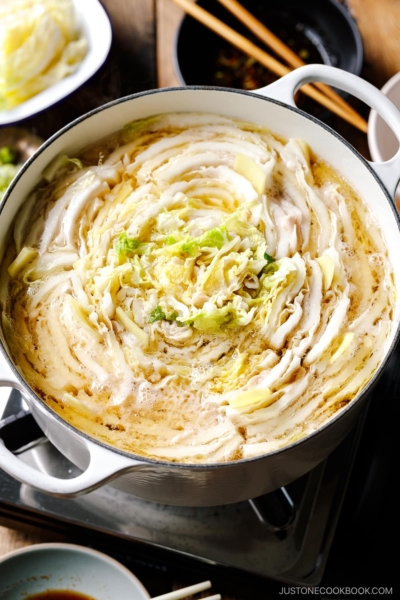
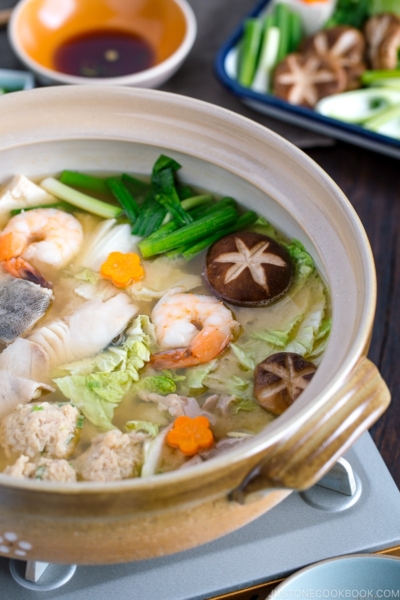




Hi Nami and team! I made this nabe for my mum’s birthday and it was an absolute hit! Loved the subtle but flavourful stock/soup. I’ll definitely be making this again 😊😊
Hi Sanika! Aww. 🥰 Happy Birthday!
Nami and all of us at JOC are so happy to hear you and your family enjoyed this hot pot.
Thank you so much for taking the time to read Nami’s post and trying her recipe!
Tip: Make the broth a little stronger and saltier than you think it needs to be. That’s because after you add the ingredients, especially veggies, they’ll dilute the broth.
Hi Karla, Thank you for trying Nami’s recipe and for your feedback!🙂
We have a sesame allergy in our family. Do you have a recommendation for how to modify the recipe without sesame?
Hi Cindy! Thank you so much for trying Nami’s recipe.
You can omit sesame seeds and add soy sauce to this recipe for your taste.
You can also try the different Hot Pot broths. (Scroll down to see different broth/hot pot types🙂.) https://www.justonecookbook.com/tags/hot-pot/
We hope this helps!
Made this for dinner last night and it was amazing! So satisfying and tasty and the pinch of salt and shichimi togarashi just put it over the top. Definitely adding to my regular rotation. Thanks, Nami!
Hi Yvette! Thank you so much for trying Nami’s recipe!
Nami and all of us at JOC are so happy to hear you enjoyed this dish. Thank you for sharing your cooking experience and your kind feedback!
Can you make the broth in advance and freeze it?
Hi Ken! Thank you for taking the time to read Nami’s post and try her recipe!
We don’t recommend freezing miso broth because it loses flavor. You can freeze it without the Miso and then add it when you’re ready to cook the dish.
We hope this was helpful!
Greatings from Czech Republic. I enjoy all your recipes and this is my family favorite autumn hot pot.
Hi Dušan Chaloupka! Thank you very much for trying Nami’s recipe and for your kind feedback!
Your comment made our day! We are so happy to hear your family enjoyed it. Happy Cooking!
Hi Nami & team, fantastic recipe, as always, thank you 🙂 I use your website weekly to try to recreate recipes that I loved when I used to live in Yokohama 💕 Quick question: there is no dipping sauce for this hot pot to dip the food in as you pick it from the donabe?
Thanks!
Hi Litza! We couldn’t be happier to hear how much joy and excitement Nami’s recipe has brought to you! Thank you very much for using our website weekly!
Regarding a dipping sauce, this hot pot is already flavored in the Hot Pot, and you do not need the dipping sauce. If you prefer to have a dipping sauce, we recommend reducing the Miso amount in the recipe.😉
We hope this helps!
It does help, thanks so much!
Hi Litza! You are most welcome!🙂
I haven’t tried any recipes yet (just found you), but I love the detail/photos of your posts. Can’t wait to try something soon. Thanks!
Hi Lisa! Welcome to the JOC website!
Thank you very much for your kind feedback. We hope you enjoy Nami’s many recipes!☺️
I really like the recipe, but how come can’t save to favorite? Please advice, thanks!
Hi Tiffany, Thank you very much for trying this recipe! We do not have a feature click button for saving your favorite on the website. You may print out the recipe using “PRINT” in the recipe card. We hope this helps!
Kon’nichiwan, Nami! I made this last night and it was so delicious. Light, well balanced, very flavourful. I will make it again. I’ve been making many of your recipes and have signed up for your newsletter. Thank you for sharing your recipes, culture and knowledge with us.
Hi Heather!
Aww…Thank you very much for trying this recipe and for your kind feedback!
We are so happy to hear you enjoyed this Hot Pot.🥰
Thank you so much for this recipe! My parents and I love doing hot pot at home but we were never able to find a good broth. There aren’t many store mixes available where we live and even though we tried making the broth from scratch at home, every time it never tasted as good as the broths from the restaurants! We made this one last week and it was SOOOO YUMMY! We had all of the ingredients at home already but never thought to put them together in this way! The soup was good before adding the sesame seeds but amazing after adding them in! They definitely kick up the delicious nutty flavor. Will be saving this recipe so we can use it every time we make hot pot at home! Next time we want to try it spicy!
Hi Jewelia,
Thank you very much for trying this recipe and for sharing your story.
We couldn’t be happier to hear how much joy and excitement Nami’s recipe has brought to you and your family!
We have many Hot Pot recipes available now. Please enjoy it! ☺️
https://www.justonecookbook.com/#search/q=hot%20pot
where do you get the ladle to dip inside the pot with the miso paste ? Can you explain how to use the miso instrument that you are using… What is it for? Why don’t you just use a spoon instead?
Hi Yvonne,
That is called Miso Muddler. The best tool to take out 2 Tbsp or 1 Tbsp of miso and let it dissolved to make miso soup!
https://www.amazon.com/dp/B01MTXS4B5/?ref=exp_justonecookbook_dp_vv_d
If you don’t have one, of course, you can use a spoon instead. 😉
Here is Nami’s other favorite kitchen tools.
https://www.justonecookbook.com/kitchen-tools/
Made this tonight, and it was awesome. Will definitely make again. Thank you!!
Hi NN! I’m so happy to hear you enjoyed this recipe. Thank you for your kind feedback! 🙂
Hi Nami,
This nabe looks so good! Is it okay to still use regular hon dashi as the base for this sesame miso nabe or does it have to be the kombu shiitake?
Thanks!
Hi Mai! You can, but remember dashi powder like hondashi lose its flavor and fragrance as soon as it’s added. You will be most likely relying on flavors from the ingredients, not from the broth. 🙂
Thank you again, Nami, for posting such interesting recipes! This is one I hope to try with my children and their families, as it looks delicious, fun, and nutritious, too. It naturally feels more sociable when we are sharing from a common pot as in this dish. Keep up the amazing posts.
Hi Danni! Thank you for your kind feedback. I hope you and your family will enjoy this dish together. 🙂